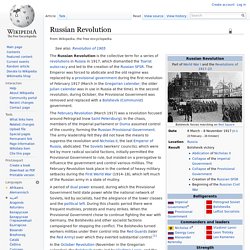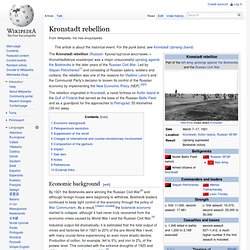

Russian Revolution. The Russian Revolution is the collective term for a series of revolutions in Russia in 1917, which dismantled the Tsarist autocracy and led to the creation of the Russian SFSR.

The Emperor was forced to abdicate and the old regime was replaced by a provisional government during the first revolution of February 1917 (March in the Gregorian calendar; the older Julian calendar was in use in Russia at the time). In the second revolution, during October, the Provisional Government was removed and replaced with a Bolshevik (Communist) government. Bolshevik. The Bolsheviks were the majority faction in a crucial vote, hence their name.

They ultimately became the Communist Party of the Soviet Union.[6] The Bolsheviks came to power in Russia during the October Revolution phase of the Russian Revolution of 1917, and founded the Russian Soviet Federative Socialist Republic which would later become the chief constituent of the Soviet Union in 1922. The Bolsheviks, founded by Vladimir Lenin and Alexander Bogdanov, were by 1905 a major organization consisting primarily of workers under a democratic internal hierarchy governed by the principle of democratic centralism, who considered themselves the leaders of the revolutionary working class of Russia.
Their beliefs and practices were often referred to as Bolshevism. Kronstadt rebellion. The Kronstadt rebellion (Russian: Кронштадтское восстание, tr.

Kronshtadtskoye vosstaniye) was a major unsuccessful uprising against the Bolsheviks in the later years of the Russian Civil War. Led by Stepan Petrichenko[1] and consisting of Russian sailors, soldiers and civilians, the rebellion was one of the reasons for Vladimir Lenin's and the Communist Party's decision to loosen its control of the Russian economy by implementing the New Economic Policy (NEP).[2][3] The rebellion originated in Kronstadt, a naval fortress on Kotlin Island in the Gulf of Finland that served as the base of the Russian Baltic Fleet and as a guardpost for the approaches to Petrograd, 55 kilometres (34 mi) away.